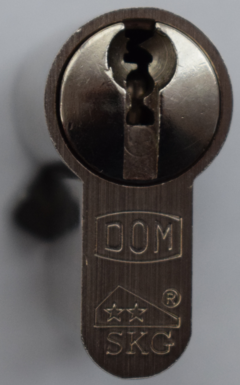DOM Sigma: Difference between revisions
(Created DOM Sigma page.) |
m (spec, rating) |
||
| (One intermediate revision by the same user not shown) | |||
| Line 8: | Line 8: | ||
| lock_design = [[Pin_tumbler|Pin-tumbler]] | | lock_design = [[Pin_tumbler|Pin-tumbler]] | ||
| patent = | | patent = | ||
| years_produced = | | years_produced = | ||
| ratings = [[EN_1303|EN 1303:2015]] | |||
| related = | | related = | ||
| spec_on = | | spec_on = true | ||
| spec_comptype = | | spec_comptype = [[Pin_tumbler|Pin-tumbler]] | ||
| spec_comp = | | spec_comp = 6 | ||
}} | }} | ||
The '''Sigma''' is a [[pin-tumbler]] lock made by [[DOM]]. It combines six pins in the standard configuration with up to 12 passive pins. | The '''Sigma''' is a [[Pin_tumbler |pin-tumbler]] lock made by [[DOM]]. It combines six pins in the standard configuration with up to 12 passive pins. The Sigma key profile is shaped to resemble the letters D O M. | ||
__TOC__ | __TOC__ | ||
| Line 24: | Line 25: | ||
:''See also: [[Pin-tumbler#Principles_of_Operation|Pin-Tumbler (Principles of Operation)]]'' | :''See also: [[Pin-tumbler#Principles_of_Operation|Pin-Tumbler (Principles of Operation)]]'' | ||
The lock contains six pin stacks - two chambers contain spooled drivers, the rest are tapered barrels. Keypins are standard, with a | The lock contains six pin stacks - two chambers contain spooled drivers, the rest are tapered barrels. Keypins are standard, with a single exception being a torpedo-shaped pin. | ||
== Disassembly instructions == | == Disassembly instructions == | ||
To disassemble a double euro cylinder, use of a pinning shoe is the preferred method. | To disassemble a double euro cylinder, use of a pinning shoe is the preferred method. | ||
Other possibility is to use a segmented follower, but that requires that both cores are pulled out a bit to allow a cam removal. Then a core should be rotated to approximately 4:30 or 7:30 o'clock position (135 degrees either clockwise or anti-clockwise) to prevent driver entering a gaps for the cam clutch. Then a segmented follower can be used to remove the core. | Other possibility is to use a [[Plug_follower|segmented follower]], but that requires that both cores are pulled out a bit to allow a cam removal. Then a core should be rotated to approximately 4:30 or 7:30 o'clock position (135 degrees either clockwise or anti-clockwise) to prevent driver entering a gaps for the cam clutch. Then a segmented follower can be used to remove the core. | ||
== Ratings == | |||
* [[EN 1303 |EN 1303:2015]] | |||
== Vulnerabilities == | == Vulnerabilities == | ||
| Line 58: | Line 65: | ||
* [[DOM]] | * [[DOM]] | ||
* [[Security rating]] | |||
[[Category:Lock models]] | |||
[[Category:DOM]] | [[Category:DOM]] | ||
[[Category:Pin-tumbler locks]] | [[Category:Pin-tumbler locks]] | ||
[[Category:EN 1303 locks]] | |||
Latest revision as of 02:31, 25 December 2022
DOM Sigma
| DOM Sigma | |
 | |
| Name | DOM Sigma |
|---|---|
| Manufacturer | DOM |
| Lock Type | Cylinder |
| Lock Design | Pin-tumbler |
| Security Rating(s) | EN 1303:2015 |
| Specifications | |
| # of Components | 6 |
| Component Type | Pin-tumbler |
The Sigma is a pin-tumbler lock made by DOM. It combines six pins in the standard configuration with up to 12 passive pins. The Sigma key profile is shaped to resemble the letters D O M.
Principles of operation
- See also: Pin-Tumbler (Principles of Operation)
The lock contains six pin stacks - two chambers contain spooled drivers, the rest are tapered barrels. Keypins are standard, with a single exception being a torpedo-shaped pin.
Disassembly instructions
To disassemble a double euro cylinder, use of a pinning shoe is the preferred method.
Other possibility is to use a segmented follower, but that requires that both cores are pulled out a bit to allow a cam removal. Then a core should be rotated to approximately 4:30 or 7:30 o'clock position (135 degrees either clockwise or anti-clockwise) to prevent driver entering a gaps for the cam clutch. Then a segmented follower can be used to remove the core.
Ratings
Vulnerabilities
The DOM Sigma is vulnerable to one or more of the following:
Gallery
References






